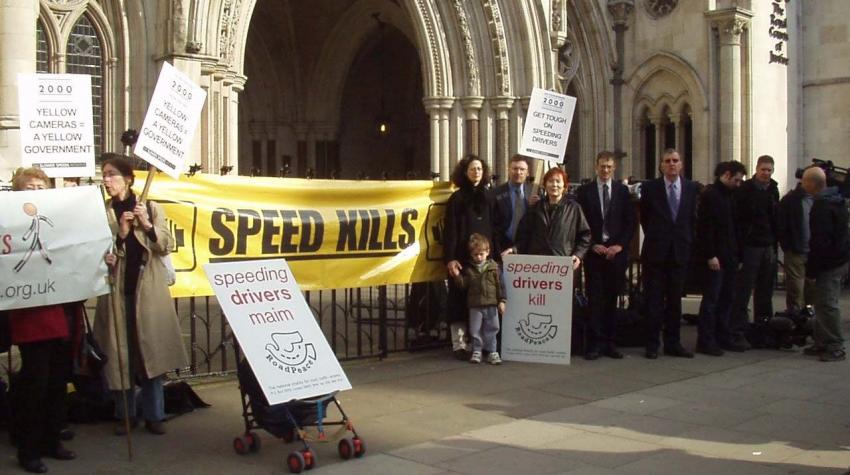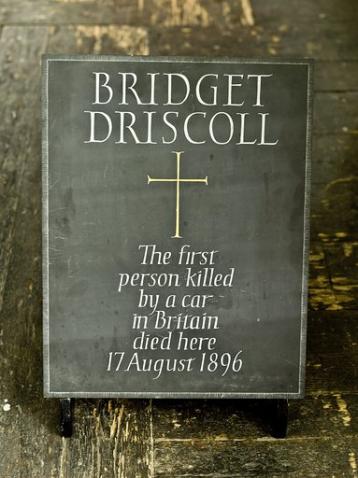
Protest connected with speed cameras, outside the High Court in London, 2003. Photo courtesy of the author.
18 May 2021
Nearly 13 years ago, in November 2008, I wrote an article with an almost identical title for the first edition of the UNECE Transport Review , in which I mentioned that in 1896, a pedestrian became the first person ever to be killed by a car driver.
Since we are commemorating the 125th anniversary of that first road death this year, it is fitting to give some details about this event, which this quote from a 14 April 2004 United Nations press release (GA/10236) provides:
"LEE JONG-WOOK, Director-General of the World Health Organization (WHO), recalled that the first person to be killed by a car had been Bridget Driscoll, a 44-year-old mother of two, who was knocked down at London’s Crystal Palace on 17 August 1896. The car had been travelling at 12 km per hour. Speaking at the inquest, the British coroner had warned: 'This must never happen again.' The world, to its great loss, had not taken his advice."
Despite the coroner’s words, neither the driver nor his employers were charged with causing Mrs. Driscoll’s death or committing any other offence; the inquest verdict labelled her death “accidental”, in other words, brought about by chance or bad luck. We know of no steps that were taken for a thorough examination of cause, effect and likely remedy that might prevent a similar death from occurring in the future.
A very dangerous precedent was set all those years ago and the result has been a carnage of terrifying proportions, which is still continuing day in and day out. While the true figures of people killed, maimed and hurt worldwide since 1896 will never be fully known, it is estimated that over 50 million have been killed and hundreds of millions injured. Heathcote Williams in his poem “Autogeddon” refers to this global toll as “the third world war nobody bothered to declare”.
Today we might liken it to an ongoing pandemic, one that affects primarily our vulnerable and our young.
A pandemic that, besides the impact of bereavement and injury trauma, also has a devastating economic impact. A pandemic that affects low- and middle-income countries most of all, is said to cost them more than they receive in development assistance2 and tips many families into poverty.3
A pandemic that finally, in 2004—108 years after Bridget Driscoll’s death—was placed on the World Health Assembly agenda and acknowledged as a major public health issue.
As a result, the United Nations Road Safety Collaboration (UNRSC) was established and road safety days, weeks and conferences were introduced. The World Day of Remembrance for Road and Traffic Victims (the third Sunday in November each year), which road victim organizations, under the umbrella of the European Federation of Road Traffic Victims (FEVR), led by RoadPeace, had observed in many countries since 1995, was adopted by the United Nations General Assembly in resolution 60/5 of 26 October 2005, through support from WHO, especially Dr. Etienne Krug. The Decade of Action for Road Safety 2011-2020, with its own Global Plan, was also launched and completed.
Yet to date, there has been little or no progress in reducing the annual 1.35 million road fatalities (3,700 a day) and 20 to 50 million injuries. Depressingly, no percentage at all of the 50 per cent reduction target has been achieved over the past decade. That target was called “ambitious”, but to road victims and road victim advocates, only a 0 per cent target is acceptable—Vision Zero—since a 50 per cent target actually means that each year 700,000 road deaths and millions of road injuries are expected and planned in, something that would be unthinkable for deaths and injuries caused in any other way.
We greatly welcome the theme of lower speeds—"Streets for Life: #Love30” for this year’s UN Global Road Safety Week because we know that low speeds have the potential to save lives. However, this potential will only be achieved if, in addition to promotion, lower speed observance is ensured through strict enforcement and meaningful sanctions for non-observance.
Non-compliance with traffic rules is the principal cause of road deaths and injuries; therefore, a serious investigation of fatal and injury crashes to identify the main causation factors, followed by legal actions if appropriate, should form a crucial part of road casualty prevention work. Yet amazingly, it doesn’t, which is likely to be the very reason for the unrelenting scale.
For the last Global Road Safety Plan, FEVR, as a member of UNRSC, lobbied successfully for Activity 5 to be added to Pillar 5—post-crash response: “Encourage a thorough investigation into the crash and the application of an effective legal response to road deaths and injuries and therefore encourage fair settlements and justice for the bereaved and injuries”.4 Unfortunately, it seems that Activity 5 has yet to become active worldwide.
Enforcement, investigation and legal response ought to become an integral part of road crash prevention work to finally achieve a shift from the current unacceptable carnage. They need to be part of “post-crash response” in the new Global Plan and to be put into practice.
Non-governmental organization “Brussels Declaration”
For the first Decade of Action for Road Safety 2011–2020, non-governmental organizations (NGOs) advocating for road victims and road danger reduction compiled 33 recommendations to governments in the NGO “Brussels Declaration”.
The Declaration was signed by 70 NGOs from 40 countries, who came
together in Brussels in May 2009, 12 years ago, at a meeting hosted by
WHO, and who subsequently, over the course of six months, sent their
proposals, comments and agreement to the recommendations in five main
areas: general approach; prevention; post-crash response; worldwide
learning; and joint initiatives and actions.
Of the 70 NGOs, 12 were FEVR member organizations, the others
individual NGOs from all continents. Many of the latter are now
affiliated to the subsequently set up Global Road Safety Partnership and International Road Victim Partnerships.
The NGO Declaration was launched at the First Global Ministerial Conference on Road Safety in Moscow in November 2009, where a Moscow Declaration was also launched.

Re-launch of NGO recommendations for Decade 2021-2030
These important recommendations have yet to be realized, therefore deserve and require a re-launch for the coming decade—with an appeal that they will be put into action.
Summary of NGO recommendations for the ‘Decade of Action’
Advocacy NGOs representing road victims and road users have a particular interest in an improved road safety situation, indeed a fatality-free global road transport network. Many such NGOs were set up by people who have suffered bereavement or injury through a road crash and were motivated by their personal suffering to help other victims or engage in road safety activities.
In May 2009, more than 100 representatives of 70 NGOs from 40 countries came together for the first time in Brussels at a meeting hosted by WHO. Using their unique expertise and perspective, participants compiled 33 recommendations to improve road safety in five subject areas. Below is a summary of their key recommendations to Governments.
GENERAL APPROACH
The road is a public domain as well as a network to link people.
Therefore, NGOs call on Governments to:
- change transportation policy drastically, giving top priority to safety and sustainable mobility
- address traffic-danger related injuries and mobility as a public health and human rights issues
- design roads taking account of the role of the public space and rights/needs of vulnerable road users
- Avoid use of the word "accident" to the extent possible as it implies an event which happens without apparent cause
PREVENTION
It is our duty to reduce road casualties to as close to zero as possible.
Therefore, NGOs ask Governments to:
- lead by example in managing risks
- provide resources for research and strict enforcement and reform of traffic laws
- establish a sustainable financing mechanism for road safety
- adopt global standards for traffic police training, driver training and licensing
POST-CRASH RESPONSE
Serious post-crash response is a vital component of effective road safety policy and includes: immediate rescue interventions, thorough investigations, criminal and civil proceedings if appropriate, long-term rehabilitation/support.
Therefore, NGOs expect Governments to guarantee:
- improved emergency services and early rehabilitation to minimize road trauma
- national standards of social, medical and legal care to injured victims and bereaved families
- thorough investigations in order to identify all preventable causes and ensure justice for victims
- an effective, proportionate and deterrent response to traffic law violations involving death or injury
WORLDWIDE LEARNING
It is essential to return to sustainable mobility modes in the face of the enormous cost in human lives and the effect of pollution on climate change.
Therefore, NGOs ask that Governments pay particular attention to:
- accommodating and integrating all different modes of mobility in the design of all roads
- providing safety and comfort for vulnerable road users
JOINT INITIATIVES AND ACTIONS
NGOs offer Governments their cooperation, expertise and joint initiatives, in return for partnership, secure funding, and support for their work.
The NGOs propose:
- national advocacy networks – to ensure nationwide advocacy for road safety and road victims
- joint observance of the World Day of Remembrance, a Day initiated by victims, as an opportunity for highlighting the consequences of road danger and impact of road death and injury
- establishment of a national memorial to road victims in the capital city of every country
- establishment of an International Coalition Against Road Trauma (ICART), made up of national Coalitions Against Road Trauma
May the 125th anniversary year of Bridget Driscoll’s death, with the launch of the Sixth UN Global Road Safety Week (and the new Decade of Action 2021–2030), become the turning point in the casual treatment of culpable road deaths and injuries, and with it lead to their eventual elimination.
And may the widest possible observance of the World Day of Remembrance help achieve this with its spotlight on the profound consequences of road danger, i.e. the impact of traumatic bereavement and injury and its high cost to families, communities and countries.
Reducing the toll will represent the best support and recognition for road victims everywhere.
Notes
1 Brigitte Chaudhry, “Road Deaths and Injuries Shatter Lives: The Reason for a Serious Post Crash Response”, UNECE Transport Review, (November 2008), pp. 35–36. Available at https://unece.org/fileadmin/DAM/trans/doc/2008/UNECE-Transport-Review-1-2008.pdf.
2 Koustuv Dalal and others, “Economics of Global Burden of Road Traffic Injuries and Their Relationship with Health System Variables”, International Journal of Preventive Medicine, 4(12) (December 2013) pp. 1442–1450. Available at https://www.ncbi.nlm.nih.gov/pmc/articles/PMC3898451/.
3 “Poverty & Road Safety: A Global Road Safety Partnership Positioning Paper”, International Federation of Red Cross and Red Crescent Societies. Available at https://www.grsproadsafety.org/wp-content/uploads/New-Fact-Poverty-PDF.pdf.
4 World Health Organization, Global Plan for the Decade of Action for Road Safety 2011-2020, p. 17. Available at https://www.who.int/roadsafety/decade_of_action/plan/plan_english.pdf?ua=1.
The UN Chronicle is not an official record. It is privileged to host senior United Nations officials as well as distinguished contributors from outside the United Nations system whose views are not necessarily those of the United Nations. Similarly, the boundaries and names shown, and the designations used, in maps or articles do not necessarily imply endorsement or acceptance by the United Nations.

Δεν υπάρχουν σχόλια:
Δημοσίευση σχολίου